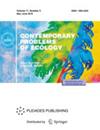Macrozoobenthos in Different Types of Littoral Zones of Lake Onego
IF 0.5
4区 环境科学与生态学
Q4 ECOLOGY
引用次数: 0
Abstract
The results of studies of bottom biocenoses in three types of littoral zone (rocky biotope, gravel-sand biotope, and surf zone with thickets of higher aquatic vegetation) of Lake Onego in 2013 and 2014 are presented. Our data show that, among the three types of coastal zone, the macrozoobenthos biomass is maximal in the rocky littoral zone (3.4–6.6 g/m2) and is minimal in the sandy zone (0.1–0.2 g/m2). The invasive species Gmelinoides fasciatus (Stebbing 1899) (CRUSTACEA: AMPHIPODA) has successfully naturalized in all types of littoral zones of the reservoir in recent decades. This species dominates both in number and biomass in the rocky type of biotope.

奥涅戈湖不同类型沿岸带的大型底栖动物
摘要 介绍了 2013 年和 2014 年对奥涅戈湖三种类型沿岸带(岩石生物群落、砾石-沙生物群落和具有高等水生植被丛的冲浪带)底部生物群落的研究结果。我们的数据显示,在三种类型的沿岸带中,大型底栖生物的生物量在岩石沿岸带最高(3.4-6.6 克/平方米),在沙质沿岸带最低(0.1-0.2 克/平方米)。近几十年来,入侵物种 Gmelinoides fasciatus(Stebbing 1899)(爬行纲:蛙形目)成功地在水库的所有类型沿岸带归化。在岩石类型的生物群落中,该物种的数量和生物量均占优势。
本文章由计算机程序翻译,如有差异,请以英文原文为准。
求助全文
约1分钟内获得全文
求助全文
来源期刊

Contemporary Problems of Ecology
环境科学-生态学
CiteScore
1.40
自引率
12.50%
发文量
54
审稿时长
6-12 weeks
期刊介绍:
Contemporary Problems of Ecology is a multidisciplinary periodical that publishes original works on the following subjects: theoretical and methodical issues of ecology, regional aspects of ecology, regional ecological disasters, structure and functioning of ecosystems, anthropogenic transformation of ecosystems. All basic aspects of modern ecology, including the most complicated interactions between living organisms and their environment, are presented. Some of the journal issues are dedicated to global changes in biological diversity at various levels of organization (populations, species, ecosystems) principles and methods of nature conservation.
 求助内容:
求助内容: 应助结果提醒方式:
应助结果提醒方式:


